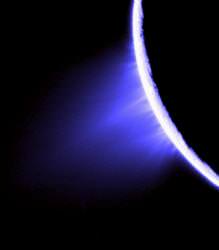One of the biggest discoveries made by Cassini is at Saturn’s moon Enceladus, where great plumes of icy material were seen spewing from its southern pole. Now scientists think that this material is traveling all the way inward to get trapped into Saturn’s A-ring.
Scientists had already linked together Saturn’s E-ring with the material spewed out by Enceladus. And researchers had worked out that the whole magnetic environment around Saturn is weighed down by the Enceladus material, which becomes plasma.
But now this.
“Saturn’s A-ring and Enceladus are separated by 100,000 kilometers (62,000 miles), yet there’s a physical connection between the two,” says Dr. William Farrell of NASA’s Goddard Space Flight Center in Greenbelt, Md. “Prior to Cassini, it was believed that the two bodies were separate and distinct entities, but Cassini’s unique observations indicate that Enceladus is actually delivering a portion of its mass directly to the outer edge of the A-ring.” Farrell is lead author of a paper on this Saturn discovery that appeared in Geophysical Research Letters January 23.
The gas particles are ejected from Enceladus and then become electrically charged by sunlight and through interactions with other particles. Once they’re charged, the particles can come under the sway of Saturn’s magnetic field, which traps and directs them around. The particles can move around from pole to pole, but once they enter Saturn’s A-ring, they’re stuck there for good.
Scientists had actually predicted this in the early 1990s. Using the Hubble Space Telescope, they saw a large presence of water-related molecules in orbit around Saturn. The researchers modeled the motions of this icy material, and calculated that it could migrate all the way in to the A-ring. But the source of this water cloud was unknown.
This discovery backs up the prediction, and provides a source for the cloud of water-related molecules feeding into the A-ring.
They’re coming from Enceladus.
Original Source: NASA News Release


Scientists think that where there is liquid water, there is life.
Bacteria that survived on a camera for years on a Apollo camera was brought back to life and revived.
Could we send a spacecraft through the ring and get samples of Enceledian life?
Too dangerous to fly through the rings — the spacecraft would never survive, but there they certainly could fly through the plumes, as Cassini will be attempting to do later this year. It will fly within 50km of the moon’s surface to see what it can discover.
A spacecraft similar to the “Stardust” mission could surely fly through the plumes of Enceladus and return samples to the Earth.
A mission like that would take years and no one responsible for these types of mission will approve it without getting all information possible with the means available. What I mean is: Cassini is out there, and until it runs out of power or data to send (the former being much more likely than the later) scientists will continue to suck every bit of data they can before thinking of something like that.
Tacitus,
According to my information, Cassini itself has proven you wrong.
“Too dangerous to fly through the rings — the spacecraft would never survive”
Cassini flew through the rings on it’s insertion orbit.
There isn’t enough gravity to make the rings dense enough to be destructive. Remember, they’re held in place by tiny moons.
How much ice is on Saturn?
The website I gave you is my friends.
I think NASA should bring back materials from Saturn to put on the internet.